Blagdon Lake Birds
September 2019 News
Sunday 1st September [Sunny & warm]
Nick Wilcox-Brown very kindly texted me news of 2 juvenile Marsh Harriers Circus aeruginosus and a Hobby Falco subbuteo at Top End late this afternoon.
In the evening, Ken Anstey, Mark and I carried out a short bat trapping session at Chew Valley Lake and caught 22 bats of 7 species.
Monday 2nd September [Sunny, but cooler than yesterday]
A brief visit this evening, cut short by the weather, saw a Common Sandpiper Actitis hypoleucos on the dam. There were probably over a thousand gulls on the lake at dusk, mainly large, that I think had been attracted by farming activities on Holt/Lag Farms.
Tuesday 3rd September [Rain early, then clearing up.]
This evening I met Mark Hynam at the lake, after I'd seen the juvenile Mediterranean Gull Ichthyaetus melanocephalus on the dam wall among all the Black-headed Gulls Chroicocephalus ridibundus. He'd spotted a Hobby Falco subbuteo hunting at Top End, and when I got there, we watched the bats feeding in front of the hide slats at almost point-blank range. Then we saw one or (possibly) two Hobbies streak past, presumably hunting the unwary bats. It was pretty dark by this time though.
Wednesday 4th September [The day improved as it went on]
Alan Bone arrived at 0500 hrs, and I drove us to Kynance in Cornwall to see a Brown Booby (the second for the UK). As we walked down to join the other twitchers on the cliff top, the bird flew past and commenced fishing in the bay in front of us with Gannets! It was the first time it had shown today, and we arrived right on cue - how lucky was that? Anyway, we watched it for half an hour, then went back to the car for a new NT parking ticket and cuppa. While we were at the car, the bird flew back to the rocks in front of us and settled on the rocks out of sight. While we hoped for it to fly again, we saw a small flock of 6 Choughs bouncing around in the wind and calling. We waited for another two hours without seeing the Booby again, so left for the long drive home.
During the evening I saw a Common Sandpiper Actitis hypoleucos on the dam down at the lake.
Thursday 5th September [Mainly sunny, with a steady breeze.]
Late this afternoon, I saw 4+ Common Sandpipers Actitis hypoleucos (one on Home Bay Point and 3 on Rugmoor Point), 6 Lapwings Vanellus vanellus on Holt Farm, a Little Egret Egretta garzetta in Rugmoor Bay, and a ♂ Kestrel Falco tinnunculus on the roadside of Indian Country pines.
There were hundreds of Black-headed Gulls Chroicocephalus ridibundus all over the lake, and a loose flock of large gulls; Lesser Black-backed Larus fuscus and Herring Larus argentatus. I decided to put the counters on the large gulls and split them into juveniles and 1st-year plus (mainly adult) birds. I counted 122 juveniles and 255 older birds. So, roughly a third were juveniles - a goodly proportion.
Friday 6th September [Showers]
I had the opportunity for a brief look around at lunchtime, but I didn't see anything worthy of mention.
Saturday 7th September [Mainly overcast]
Ken Anstey and I spent the day checking bat boxes at Chew Valley Lake. We found 3 ♂ Nathusius' Pipistrelles Pipistrellus nathusii in a single group of boxes, including one we ringed at Blagdon Lake in 2016, and a good number of Soprano Pipistrelles P. pygmaeus. I saw a Kingfisher Alcedo atthis fly along Woodford Bank while we were there too.
Avon Birds reported the sighting of a juvenile Marsh Harrier Circus aeruginosus at Blagdon Lake today.
Sunday 8th September [Sunny]
I got down to the lake this evening and met Mark Hynam. We saw 2 Hobbies Falco subbuteo hunting at dusk at Top End, and Mark saw 3 Common Sandpipers Actitis hypoleucos on Rainbow Point, 6 Lapwings Vanellus vanellus, a Kingfisher Alcedo atthis, and an egret sp. that flew off east at dusk.
Monday 9th September [Rain in the morning & drying up later]
Today, I saw a Great White Egret Ardea alba at Top End, a Brown Hare Lepus europaeus at Burmah Road, a Common Sandpiper Actitis hypoleucos on Rainbow Point and 5 Lapwings Vanellus vanellus on Holt Farm.
Tuesday 10th September
I spent the day doing bat box checks at the lake with Ken Anstey today. We had a pretty good day with the bats.
Birds spotted during our work included a Little Egret Egretta garzetta in flight over the Pumping Station, a Hobby Falco subbuteo, and a Great White Egret Ardea alba at Top End.
Wednesday 11th September
I saw a Little Egret Egretta garzetta and Hobby Falco subbuteo at Butcombe Bay and what was probably a different Hobby at Ash Tree.
Sunday 15th September
I saw a Swift sp., possibly a Chimney Swift, over Worle Station for a few minutes this afternoon. However, as I didn't have my binoculars with me there was no way I could make a positive identification. It certainly didn't have the jizz of our more familiar Common Swift.
Back at the ranch, I saw 2 Common Sandpipers Actitis hypoleucos on the dam, and in the evening carried out a short bat trapping session, during which we caught a parous ♀ Nathusius' Pipistrelle Pipistrellus nathusii.
Monday 16th September
The usual team of Phillip, Terry, Rob and I carried out the WeBS count his morning. Best birds were undoubtedly the Black-necked Grebe Podiceps nigricollis found by Phil in front of the Lodge, and the 2 juvenile Marsh Harriers Circus aeruginosus seen by Rob and I at Top End. Full count details are on the WeBS Page.
Tuesday 17th September [Sunny with a light breeze]
Sorry for the lack of news in the last week or so, but I will endeavour to fill in the gaps over the next few days. This morning the Black-necked Grebe Podiceps nigricollis was still around the Lodge area, and I also noted a Common Sandpiper Actitis hypoleucos on the dam, while from the Top End hide, I saw a juvenile Marsh Harrier Circus aeruginosus, a Great White Egret Ardea alba with a dirty metal ring on its right tarsus, 2 Little Egrets Egretta garzetta, a Wigeon Mareca penelope, a Pintail Anas acuta and the ♀ Goldeneye Bucephalus clangula among the usual wildfowl currently present.
Wednesday 18th September [Sunny & warm]
I didn't get to the lake until dusk this evening. I saw a Common Sandpiper Actitis hypoleucos on the dam but didn't spot the Black-necked Grebe near the Fishing Lodge.
Thursday 19th September [Sunny & warm]
The quite dusky, Black-necked Grebe Podiceps nigricollis was still present this afternoon, though mobile. I also saw a Great White Egret Ardea alba, 2 Little Egrets Egretta garzetta, a juvenile Marsh Harrier Circus aeruginosus, and 9 Lapwings Vanellus vanellus at Top End, a Green Sandpiper Tringa ochropus at Burmah Road, 2 Snipe Gallinago gallinago in Holt Bay and a Common Sandpiper Actitis hypoleucos on the dam.
Friday 20th September [Sunny & warm]
In the morning I joined friends Georgie, Ken and Dan to check a Dormouse box scheme on the Mendips. We found four juveniles in a box, so despite not finding any up to this point during the year, we were really pleased to know that there was still a breeding population present.
I didn't have a chance to visit the lake until the sun had gone down. I received a call from a friend who was at Chew Valley Lake late afternoon, while I was in Weston-Super-Mare. He had watched a White Stork Ciconia ciconia fly towards Blagdon. I thought it would have flown over but wanted to check when I got home - just in case! As I stopped at the dam, Martin Maill, one of the Fishery Rangers pulled up and said he'd photographed a strange bird at the other end of the lake on his phone. He showed me his shot and I knew it was the bird I was after. He had seen it some 45 minutes earlier - gulp! Thankfully, it was still there, and a handful of really local birders came to see it before it got too dark to see. My last sight of it was on the grass looking for frogs, so I guess it will have roosted overnight.
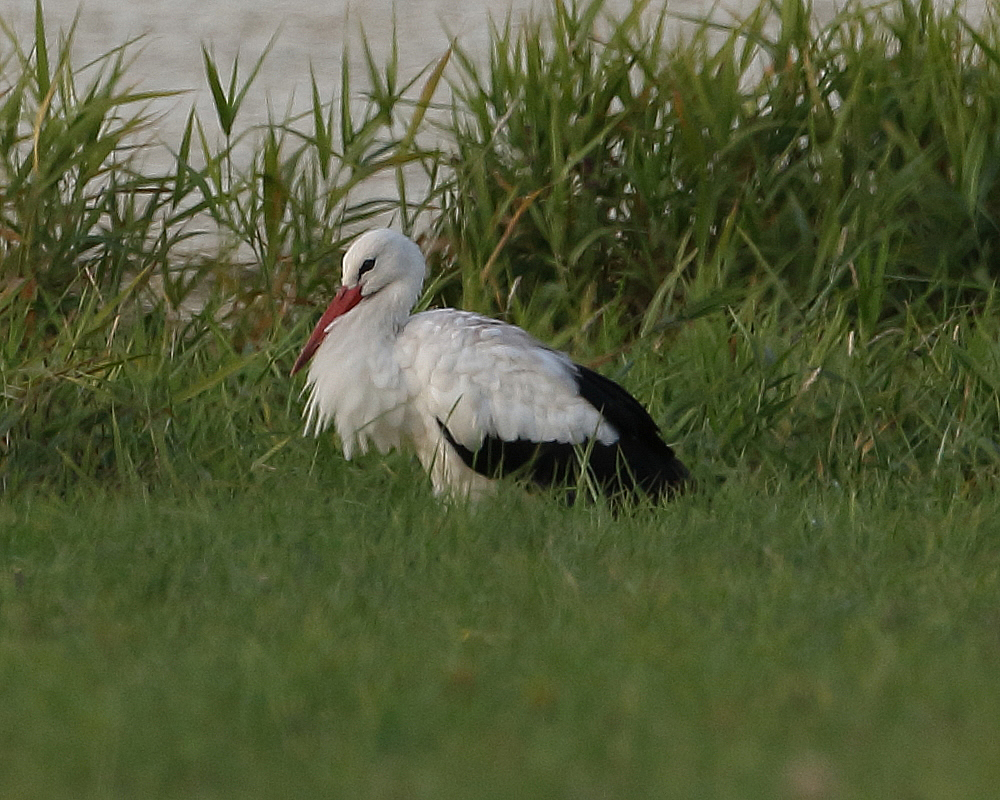
Mark and I had managed a few shots in the failing light, and it appears that it had a ring on the left leg, one of which had GB58 inscribed on it. So, it appears to be one of the birds released from the rewilding scheme at the Knepp Estate in Sussex.
I'm leading a walk for Bristol Ornithological Club in the morning, so let's hope the Stork sticks around long enough for them to see it too.
Saturday 21st September [Sunny & warm, with a stiff easterly breeze.]
This morning 12 BOC members walked much of the south side of the lake, mainly concentrating on the water birds because the woodland patches were pretty quiet. Mark Hynam and I took them along to see the White Stork Ciconia ciconia first, just in case it decided to fly before we got to Top End. However, it stuck around until 1400 hrs at least, then Mark watched it flying around being pursued by a juvenile Marsh Harrier Circus aeruginosus shortly afterwards. Pick of the 40+ species that we saw were a Red Kite Milvus milvus that flew over Top End and Ubley, 3 Great White Egrets Ardea alba, 2 Little Egrets Egretta garzetta, a ♀ Goldeneye Bucephalus clangula, an adult Common Gull Larus canus, a Common Sandpiper Actitis hypoleucos, and 4 Pintails Anas acuta. Mark saw a Hobby Falco subbuteo at Top End before the group got there as well.
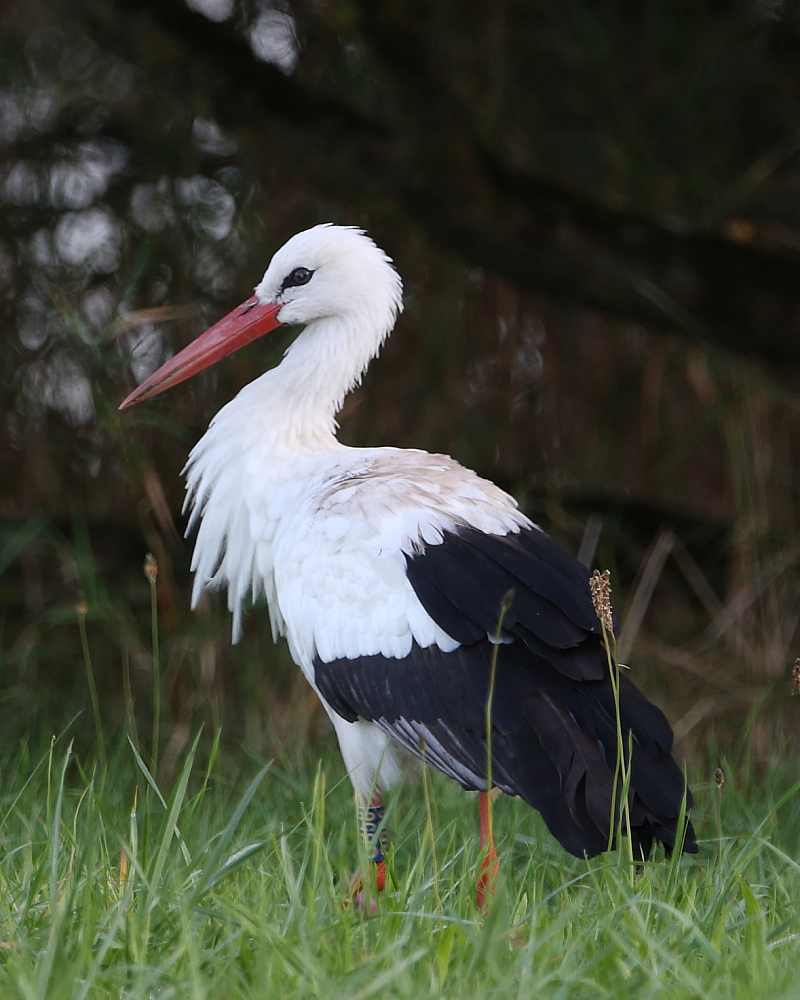
Two of the group told me they'd seen 49 species (was it?) of butterfly this year, but not Clouded Yellow Colias croceus. They are going to be so annoyed to hear I spotted one in front of the Lodge just after they'd gone! My first of the year too.
Sunday 22nd September [Showers]
It rained for much of the morning, so I waited until it stopped before going down to the lake for a look. Frankly, it was pretty quiet still, although both juvenile Marsh Harriers Circus aeruginosus were present, as were at least 3 Hobbies Falco subbuteo which put on a dazzling display from the hide catching Migrant Hawkers Aeshna mixta. There was a Common Sandpiper Actitis hypoleucos, as usual, a Green Sandpiper Tringa ochropus, 2 Great White Egrets Ardea alba, and 2 Little Egrets Egretta garzetta as supporting cast.
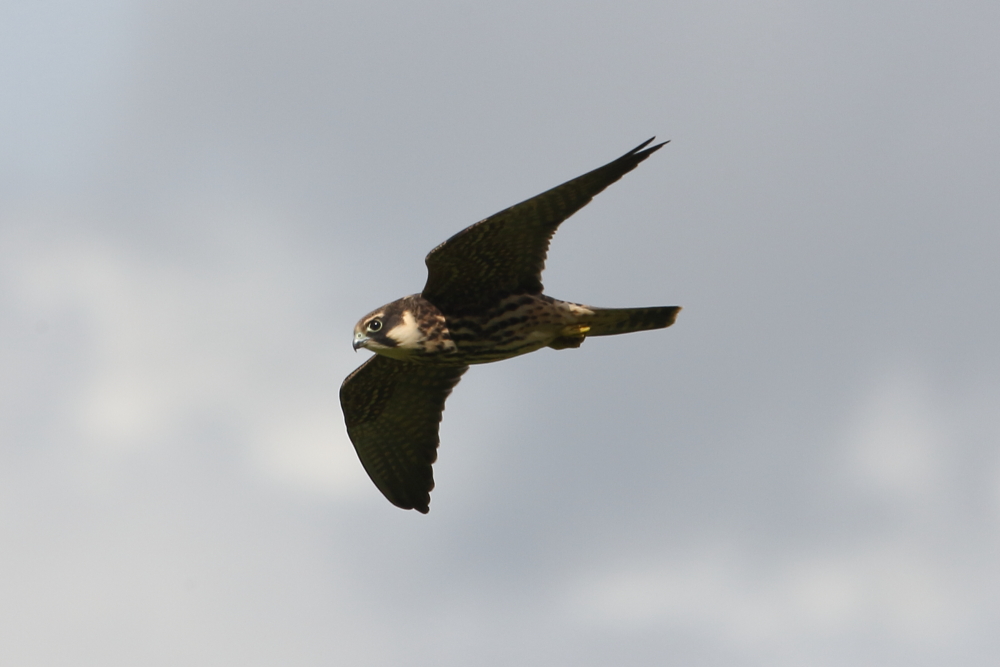
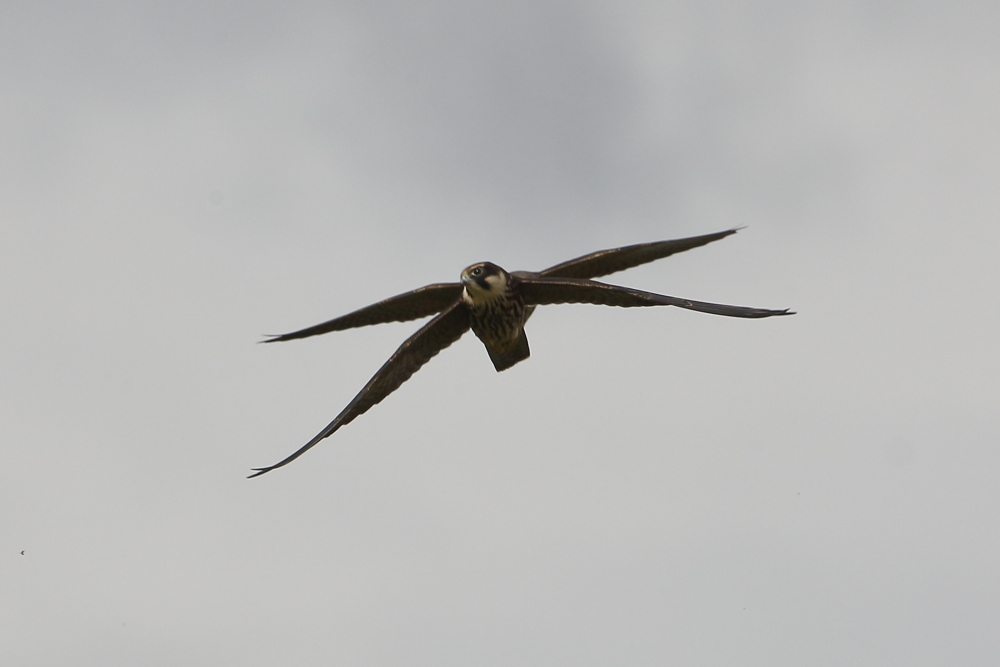
Tiny's Shallow is exposed in front of the Lodge now, so it's an opportunity to look for ringed gulls, and Mark and I spotted two this afternoon:
- Great Black-backed Gull Larus marinus, juvenile, Yellow D:GM. This is going to be one ringed on the Severn Estuary.
- Black-headed Gull Chroicocephalus ridibundus, adult, White LH45 or LH4S, I think. Will need to check this one.
Monday 23rd September [Rain on & off for most of the day] Autumn Equinox.
My visit today was in the late evening half-light and while counting egrets from Rainbow Point, 2 Great White Egrets Ardea alba and 2 Little Egrets Egretta garzetta, I was amazed to see the White Stork Ciconia ciconia prowling around along the water's edge at Top End. There was a sponsored walk along the south side of the lake yesterday supported by Bristol Water, so it's possible that the disturbance moved the Stork elsewhere - Mark and I certainly couldn't find it during the afternoon. Anyway, at dusk it walked under a Willow overhanging the water's edge to roost. While I'm writing about roosting birds, I watched the 2 Little Egrets fly into a patch of waterside Willows, where they were joined by their 2 larger cousins - normally the Great White Egrets fly off to Chew to roost. Aside from our regular Common Sandpiper Actitis hypoleucos on the dam, I didn't see any other waders. Where are they all? A Hobby Falco subbuteo put in a brief appearance in front of the hide at dusk to round off an interesting last hour of daylight.
If you're coming to see the Stork tomorrow, please stay on the road, or, look for it from the hide. It spends a lot of its time wandering around the meadows in full view, so you can get your pictures from there, like me, without chasing it around. I used my car as a hide. Mark spent quite a while watching it on Saturday, and observed it eating frogs and craneflies, as well often throwing its head back and clapping it's bill in display. I'd be interested to hear your observations if you come for a gander. I'll collate them and feed the information back to the team carrying out the re-introduction programme.
Tuesday 24th September [Early heavy rain]
The White Stork Ciconia ciconia was still present late morning, although I didn't see it until I was leaving at lunchtime when it flew overhead just behind my car at Flower Corner. I stopped at Rainbow Point where I was able to watch it in flight over Top End being accompanied by a squadron of Jackdaws Corvus monedula, and when it gained some height one of the pair of breeding Buzzards Buteo buteo also joined in the harrying. Eventually, after some 10-15 minutes the Stork landed again on the water's edge near Top End hide.
I received the following email this morning: "Thank you for your email regarding the sighting of a white stork at Blagdon Lake, North Somerset on 20/09/2019. This is indeed one of our white storks and is one of our free flying adults who came to us in 2018 from Poland. We have had multiple sightings of her in your area over the last few days. The sightings coming in are vital for the project to learn about how these birds are behaving post release and we are monitoring their movements closely. Thank you for providing so much information. You can find out more via www.whitestorkproject.org and on our twitter account @ProjectStork where we will be posting regular updates."
The only other birds of note that I saw during my visit were 2 Great White Egrets Ardea alba, a Hobby Falco subbuteo, 20 Lapwings Vanellus vanellus, and 4 Pintails Anas acuta. The ringed juvenile Great Black-backed Gull Larus marinus Yellow D:GM was on Tiny's Shallow again too.
Wednesday 25th September [Dry for most of the day]
Keith Williams reported seeing and photographing the White Stork Ciconia ciconia at Blagdon Lake this morning (per Avon Birds). However, it flew from Top End to Rugmoor before taking off shortly after midday and was lost to sight. It, or another, was seen in flight over Stanton Drew later in the afternoon.
I spent the last hour of daylight at the lake and picked out a marsh tern over Top End. It seemed to have a distinctive pale uppertail/rump and so I immediately started to consider the possibility of its being a White-winged Black Tern. However, after much observation, with it eventually settling on Wookey Point at dusk, I concluded that it was a juvenile Black Tern Chlidonias niger after all. It had 'collar pegs' and the mantle was concolorous with the wings. Close, but no banana! The two other birds of note were singles of Great White Ardea alba and Little Egret Egretta garzetta that went to roost.
Thursday 26th September [Dry early on]
This morning I went back to look for the tern I saw last night, and found it still over Top End and can confirm it was a Black Tern Chlidonias niger. There wasn't a great deal else to excite, just the Common Sandpiper Actitis hypoleucos on the dam, 20 Lapwings Vanellus vanellus, 2 Great White Egrets Ardea alba, and one of the juvenile Marsh Harriers Circus aeruginosus.
Later, I saw 2 Little Egrets Egretta garzetta at roost, and spotted a photograph taken by Raoul Chandrasakera on Avon Birds that shows 2 juvenile Marsh Harriers present again.
Friday 27th September [Rain early then showers. Windy.]
Where are all the migrating birds? A recent paper by Ken V Rosenberg et al in the US posted the following abstract "Species extinctions have defined the global biodiversity crisis, but extinction begins with loss in abundance of individuals that can result in compositional and functional changes of ecosystems. Using multiple and independent monitoring networks, we report population losses across much of the North American avifauna over 48 years, including once common species and from most biomes. Integration of range-wide population trajectories and size estimates indicates a net loss approaching 3 billion birds, or 29% of 1970 abundance. A continent-wide weather radar network also reveals a similarly steep decline in biomass passage of migrating birds over a recent 10-year period." So, clearly there are huge problems in continental North America, but one can't escape from the fact that during the last few years at Blagdon there is an undoubted decline in migrants, especially at this time of year. It's getting quite disturbing to go down to the lake day after day and see so few migrants coming through.
Today, I set out with hope, but this was quickly quashed. All I found was the juvenile Black Tern Chlidonias niger, 2 Great White Egrets Ardea alba, a Hobby Falco subbuteo, a Common Sandpiper Actitis hypoleucos on the dam, 2 Wigeon Mareca penelope, and 4 Pintails Anas acuta of note. Mark saw a Little Egret Egretta garzetta later in the day, but this was all rather similar to previous days if we're honest. Tomorrow's another day though...
Saturday 28th September [Heavy rain showers]
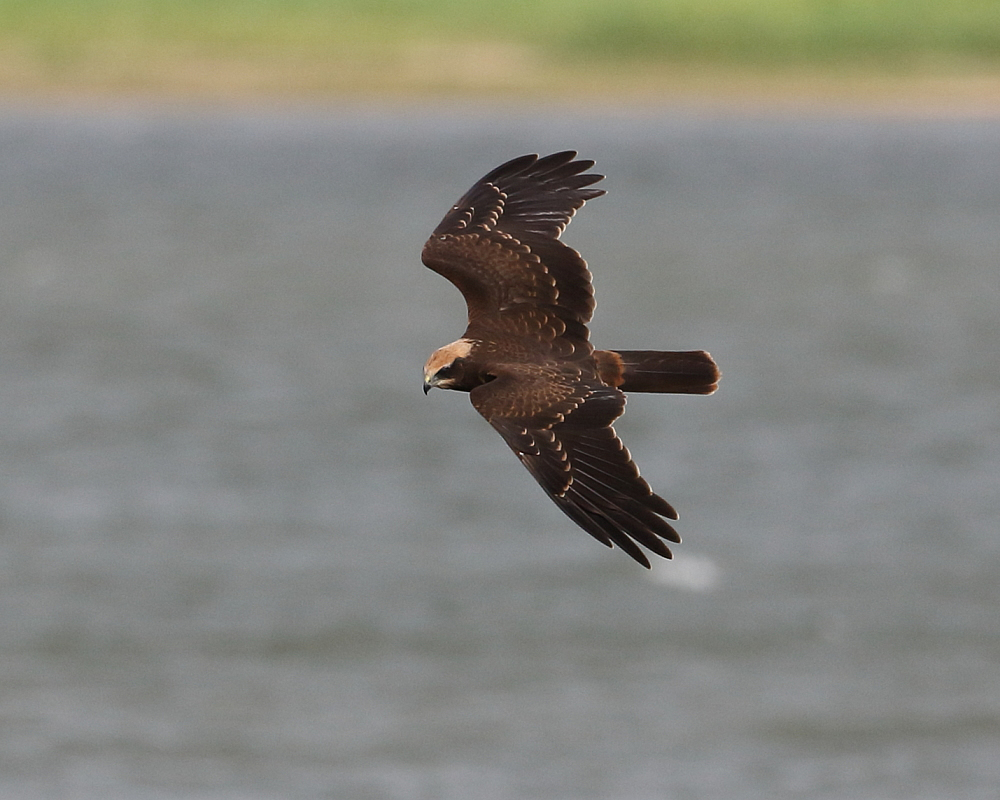
Yay! A juvenile Dunlin Calidris alpina turned up for a while this morning, until it was disturbed from Wookey Point by 2 juvenile Marsh Harriers Circus aeruginosus. Mark and I also saw a juvenile Hobby Falco subbuteo, 21 Lapwings Vanellus vanellus, 4 Pintails Anas acuta, 5 Wigeon Mareca penelope, the juvenile Black Tern Chlidonias niger, and a Great White Egret Ardea alba. At the Lodge there were 13 Great Black-backed Gulls Larus marinus, and on the dam the Common Sandpiper Actitis hypoleucos was still present.
Sunday 29th September [A storm overnight. Showers & wind throughout the day.]
I went down to RSPB Bowling Green Marsh at Topsham before dawn this morning with Mark Hynam. He wanted to see his first Long-billed Dowitcher Limnodromus scolopaceus and, sure enough, it was feeding right in front of the hide when we arrived at first light. We spent a few hours watching the waders at close quarters during the top of the spring tide and got a few snapshots for the record.
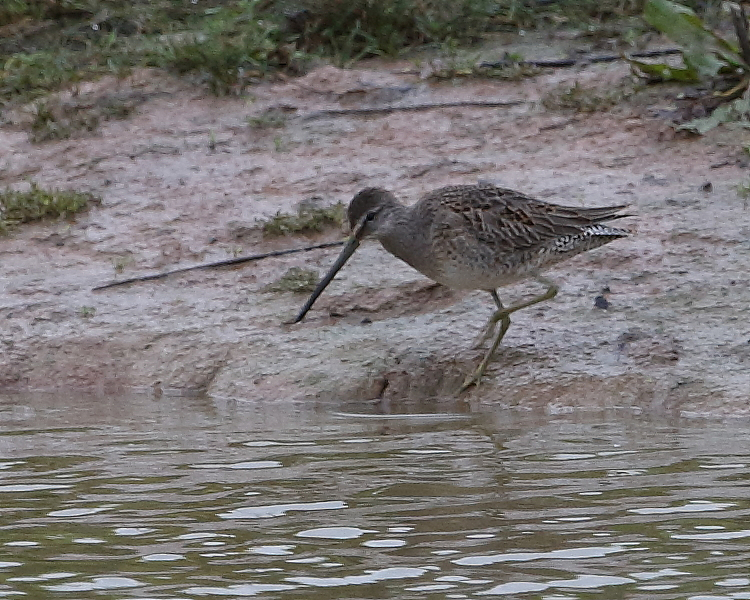
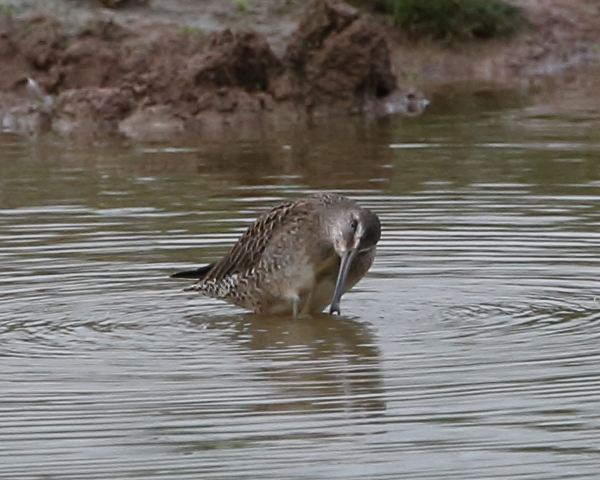
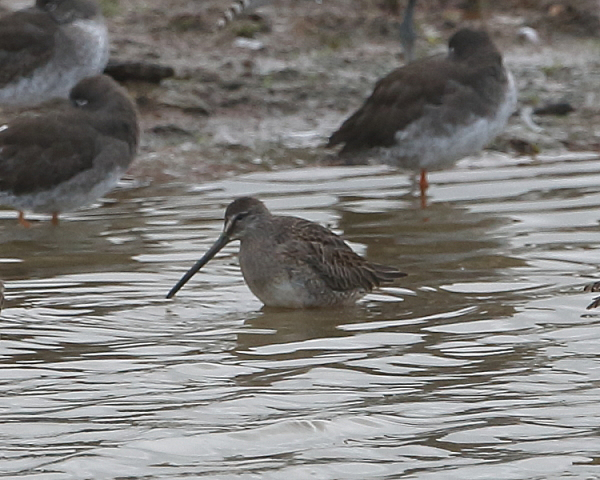
Aside from the dowitcher, we saw an incredible flock of 41 Greenshanks, 2 Knot, and a Curlew Sandpiper among the hoardes of shorebirds.
Later in the day, I got down to Blagdon Lake and saw a Dunlin Calidris alpina, a Black Tern Chlidonias niger, an Arctic Tern Sterna paradisaea and 108 Pochards Aythya ferina.
Monday 30th September
I had a look at the lake this morning and saw 2 Great White Egrets Ardea alba, 2 Little Egrets Egretta garzetta, a juvenile Marsh Harrier Circus aeruginosus, 58 Shovelers (at Top End) and 55 Great Crested Grebes Podiceps cristatus.